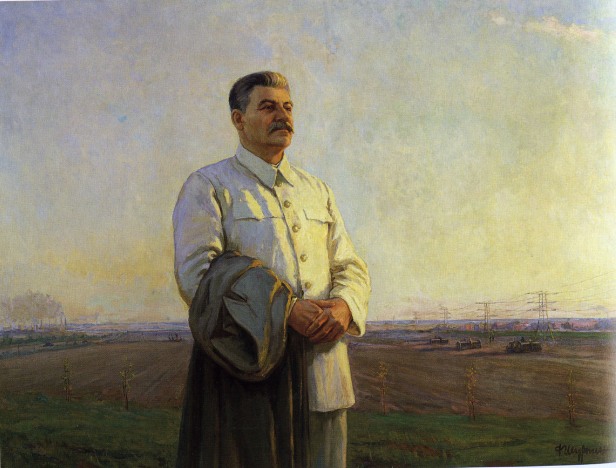Space and Stalin
Examining the spatial relationship between art and the subject of a painting (in this case Soviet Art and Stalin), goes unnoticed by the untrained eye. However, anyone with an appreciation of art and the meaning behind it instead of those who merely look for the aesthetics can appreciate the deeper meaning. In Jan Plamper’s chapter on The Spacial Poetics of the Personality Cult, he examines how Soviet artists used space juxtaposed with their subject, Stalin.
He focuses on Stalin’s personality cult and its translation to primarily paint on canvas. Plamper states that the origins of this spatial pattern of centralizing the most important subject in a painting was first studied in depth in the 1920s. The power dynamic between the figure who is most dominate and the other subjects in the painting is also examined. There is also another spatial dynamic in particular to the case of Stalin and his cult of personalities. He notes the use of concentric circles and their depiction to authority pictures. He states that in many paintings the small cults of leaders are concentrically placed around their overarching patriarch, Stalin. Plamper states others have studied these power dynamic and spatial relationships, but in his thesis he takes it one step farther. Plamper’s thesis scrutinizes centrality and sacredness. He postulates:
“The closer a person is to the center of society, the more sacredness is attributed to that person. The person placed closest to the center of society embodies the sacred most powerfully.”
In this famous painting below, Stalin is clearly the center of the painting with all lines converging to a vanishing point behind him. He is in white which could be symbolism of sacredness, purity, or rebirth. Plamper argues that the smoke stacks in the background create concentric circles radiating around Stalin, but these are fine details. Overall, I agree with the argument Plamper is making and found it really interesting, with a trained eye how much more a viewer can see with a painting. Centrality, concentric circles, sacredness and patriarchy are themes Plamper strikes in this chapter which breaks down what some may think is just a “pretty picture” or sole “propoganda.”

Morning of the Motherland by F. S. Shurpin
Interesting link: When I was doing some further research on Stalin and the spatial relationship in artwork, I found this link that examines Plamper’s argument of geometry and centrality and provides further historiography and some contrasting arguments: